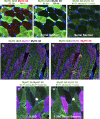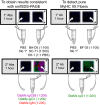Fiber typing human skeletal muscle with fluorescent immunohistochemistry
- PMID: 31697594
- PMCID: PMC6957370
- DOI: 10.1152/japplphysiol.00624.2019
Fiber typing human skeletal muscle with fluorescent immunohistochemistry
Abstract
Skeletal muscle myosin heavy chain (MyHC) fiber type composition is a critical determinant of overall muscle function and health. Various approaches interrogate fiber type at the single cell, but the two most commonly utilized are single-muscle fiber sodium dodecyl sulfate-polyacrylamide gel electrophoresis (smfSDS-PAGE) and fluorescent immunohistochemistry (IHC). Although smfSDS-PAGE is generally considered the "gold standard," IHC is more commonly used because of its time-effectiveness and relative ease. Unfortunately, there is lingering inconsistency on how best to accurately and quickly determine fiber type via IHC and an overall misunderstanding regarding pure fiber type proportions, specifically the abundance of fibers exclusively expressing highly glycolytic MyHC IIX in humans. We therefore 1) present information and data showing the low abundance of pure MyHC IIX muscle fibers in healthy human skeletal muscle and 2) leverage this information to provide straightforward protocols that are informed by human biology and employ inexpensive, easily attainable antibodies for the accurate determination of fiber type.
Keywords: MyHC; SDS-PAGE; immunohistochemistry.
Conflict of interest statement
No conflicts of interest, financial or otherwise, are declared by the authors.
Figures



References
-
- Andersen JL, Mohr T, Biering-Sørensen F, Galbo H, Kjaer M. Myosin heavy chain isoform transformation in single fibres from m. vastus lateralis in spinal cord injured individuals: effects of long-term functional electrical stimulation (FES). Pflugers Arch 431: 513–518, 1996. doi:10.1007/BF02191897. - DOI - PubMed
Publication types
MeSH terms
Substances
Grants and funding
LinkOut - more resources
Full Text Sources

